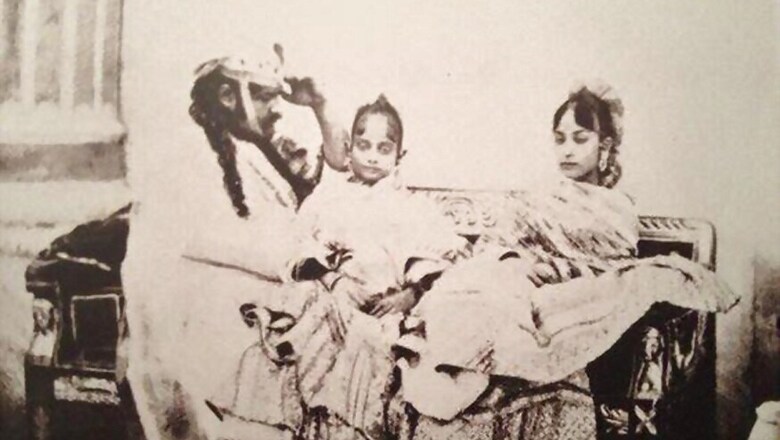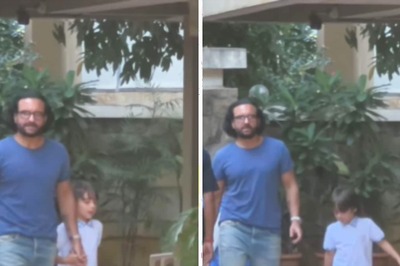
views
New Delhi: The Prince who died in Malcha Mahal was a pauper. Not just in the life he lived but also in the claims he made about his family lineage. At least that’s what the descendants of Wajid Ali Shah and Begum Hazrat Mahal, currently living in Kolkata, will have you believe in.
They are not the only one calling the Malcha Mahal prince an imposter. Many old families of Lucknow that have for long maintained their discernment for the Royal family concur.
Taken aback by the media reports which referred to one Ali Raza— who died in New Delhi’s 14th century’s Malcha Mahal— as Prince, the living members of the Royal Family of Oudh are trying to clear the air on Nawab’s lineage.
“We want to assert our credibility as the real heirs to the title. We have in the past dealt with the menace of impersonation. My uncle also raised the issue with the government of Uttar Pradesh and the Prime Minister when the impersonator – the mother of the deceased ‘prince’ called Vilayat Mahal got an allotment in Malcha Mahal on the false claims of royalty,” said Manzilat Fatima from Kolkata, who is the “great, great grand-daughter of Wajid Ali Shah. She lives in Kolkata and spends her time working to “preserve Awadh cuisine”.
The Malcha Mahal, Fatima claims, was a Mughal hunting-house or shikargah given to Vilayat Mahal and her two children including the ‘ the dead Prince’ when the family arrived in Delhi after many a unsuccessful bid to claim the Nawab’s title in Lucknow.
The family spent days in the waiting-room of the New Delhi Railway Station before their petition to the then Prime Minister Rajiv Gandhi for temporary accommodation in Delhi was acceded to by the government.
Fatima’s 89-year-old father, Dr Kaukub Qudr Meerza, is not surprised by the reports of ‘Prince’s death', because he knows the real Prince is still alive. His Highness, and yours truly, Dr Meeraz, says “our family has witnessed the hoax for years now.”
The family says one of the immediate relatives— Prince Anjum Qudr had in-fact challenged the false claims of Vilayat Mahal before the government.
Qudr wrote a series of letters in 1975 to the UP government and then again in 1985 to Prime Minister Rajiv Gandhi informing him about the “impersonation” being done by Vilayat Mahal calling it “hoax”. The letter is available on the website of their Oudh family to keep people informed about the legend of impersonation. Qudr wrote Begum Hazrat Mahal had only one son Birjis Qadr, who was crowned in 1857.
Details regarding Qadr's children from different wives are available in Kaiserut Tawarikh Vol-2 and other books on the history of Oudh. An auto-biographical Masnavis (illustrated stories) of Wajid Ali Shah Huzn-e Akhtar or Tarikh-e Pari Khana also describe the Nawab’s lineage in some detail.
These details corroborate with other sources of information on the exiled King from the poems and Diwan of Birjis Qadr- the only son of the Begum of Oudh.
The original claimants say that there are records of the Political Pension Office of the District Collector of 24 Parganas, West Bengal, from where all heirs of Birjis Qadr drew a political pension after Qadr was assassinated in 1893 in Kolkata. Wajid Ali Shah in his will has named only one son Birjis Qadr (and no daughter) that Begum Hazrat Mahal bore him.
“Fraud of the present claimant is obvious from her very name “Begum Vilayat Mahal” because Mahal is not really an inheritable work,” said Qudr in his appeal to the various government. Mahal is a title which used to be awarded by a Muslim King or Emperor in India to his wife after she bore him a son.
Thus when Birjis Qadr was born to Begum Hazrat, that King Amjad Ali Shah awarded the revered title Mahal to the wife of his Crown Prince. Just as Mumtaz, Mughal Emperor Shahjahan’s wife acquired the title after bearing successor to the Mughal throne.
Nawab Ibrahim Ali Khan of Shish Mahal, Lucknow, where Vilayat Mahal lived briefly before leaving for New Delhi, told News 18.com that the veracity of the claims can be established from the family tree or shajra of Nawab Saadat Khan who established the Oudh dynasty in the early 16th century.
He adds, further that King Wajid Ali Shah, when he was exiled to Matia Burj, Calcutta [now Kolkata] in 1856, took all his sons and daughters with him and only his siblings, divorced wives and close relatives were left behind. Some of his progeny migrated to Pakistan and England later on. Every descendant of King Wajid Ali Shah is registered with the Kolkatta office.
For the record, any title of Maharaja, Raja, Rana or Nawab recognized by the East India Company and later by Her Majesty’s government was registered with the British Indian Association or Anjuman e Hind in 1861.
The documents are still available at Lucknow Baradari.


















Comments
0 comment